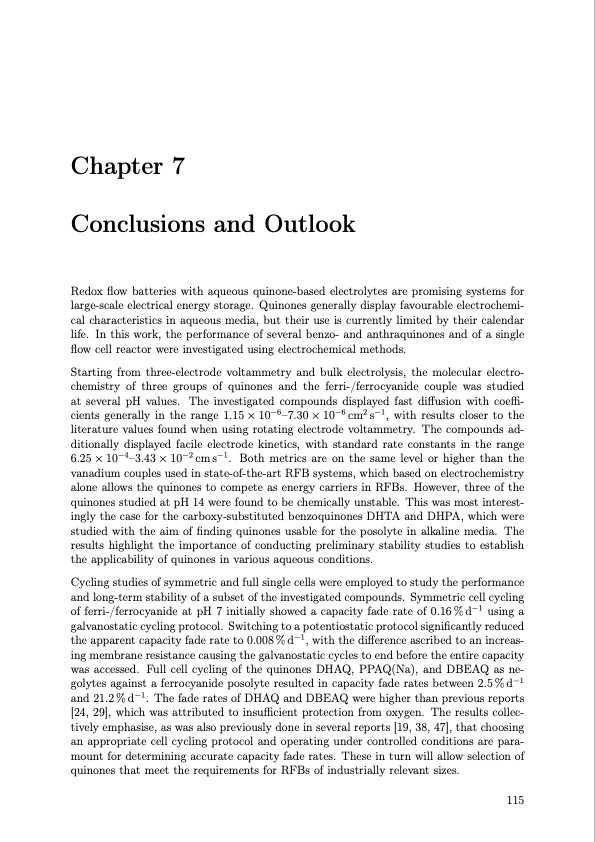
PDF Publication Title:
Text from PDF Page: 136
Chapter 7 Conclusions and Outlook Redox flow batteries with aqueous quinone-based electrolytes are promising systems for large-scale electrical energy storage. Quinones generally display favourable electrochemi- cal characteristics in aqueous media, but their use is currently limited by their calendar life. In this work, the performance of several benzo- and anthraquinones and of a single flow cell reactor were investigated using electrochemical methods. Starting from three-electrode voltammetry and bulk electrolysis, the molecular electro- chemistry of three groups of quinones and the ferri-/ferrocyanide couple was studied at several pH values. The investigated compounds displayed fast diffusion with coeffi- cients generally in the range 1.15 × 10−6–7.30 × 10−6 cm2 s−1, with results closer to the literature values found when using rotating electrode voltammetry. The compounds ad- ditionally displayed facile electrode kinetics, with standard rate constants in the range 6.25 × 10−4–3.43 × 10−2 cm s−1. Both metrics are on the same level or higher than the vanadium couples used in state-of-the-art RFB systems, which based on electrochemistry alone allows the quinones to compete as energy carriers in RFBs. However, three of the quinones studied at pH 14 were found to be chemically unstable. This was most interest- ingly the case for the carboxy-substituted benzoquinones DHTA and DHPA, which were studied with the aim of finding quinones usable for the posolyte in alkaline media. The results highlight the importance of conducting preliminary stability studies to establish the applicability of quinones in various aqueous conditions. Cycling studies of symmetric and full single cells were employed to study the performance and long-term stability of a subset of the investigated compounds. Symmetric cell cycling of ferri-/ferrocyanide at pH 7 initially showed a capacity fade rate of 0.16 % d−1 using a galvanostatic cycling protocol. Switching to a potentiostatic protocol significantly reduced the apparent capacity fade rate to 0.008 % d−1, with the difference ascribed to an increas- ing membrane resistance causing the galvanostatic cycles to end before the entire capacity was accessed. Full cell cycling of the quinones DHAQ, PPAQ(Na), and DBEAQ as ne- golytes against a ferrocyanide posolyte resulted in capacity fade rates between 2.5 % d−1 and 21.2 % d−1. The fade rates of DHAQ and DBEAQ were higher than previous reports [24, 29], which was attributed to insufficient protection from oxygen. The results collec- tively emphasise, as was also previously done in several reports [19, 38, 47], that choosing an appropriate cell cycling protocol and operating under controlled conditions are para- mount for determining accurate capacity fade rates. These in turn will allow selection of quinones that meet the requirements for RFBs of industrially relevant sizes. 115PDF Image | Organic Redox Flow Batteries 2023

PDF Search Title:
Organic Redox Flow Batteries 2023Original File Name Searched:
PhD_thesis_final_dorhoff_4_.pdfDIY PDF Search: Google It | Yahoo | Bing
Salgenx Redox Flow Battery Technology: Salt water flow battery technology with low cost and great energy density that can be used for power storage and thermal storage. Let us de-risk your production using our license. Our aqueous flow battery is less cost than Tesla Megapack and available faster. Redox flow battery. No membrane needed like with Vanadium, or Bromine. Salgenx flow battery
| CONTACT TEL: 608-238-6001 Email: greg@salgenx.com | RSS | AMP |